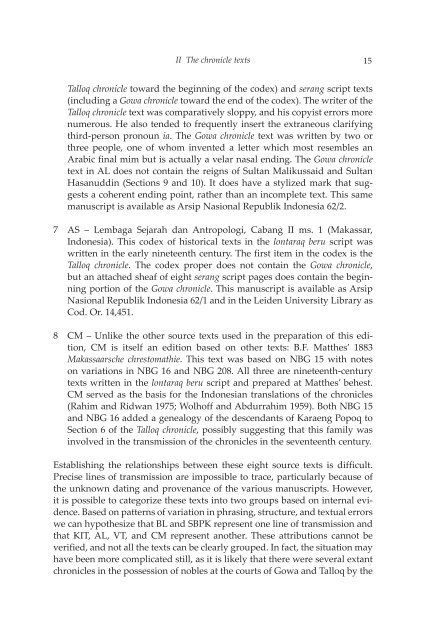A CHAIN OF KINGS - Books and Journals
A CHAIN OF KINGS - Books and Journals
A CHAIN OF KINGS - Books and Journals
Create successful ePaper yourself
Turn your PDF publications into a flip-book with our unique Google optimized e-Paper software.
II The chronicle texts 15<br />
Talloq chronicle toward the beginning of the codex) <strong>and</strong> serang script texts<br />
(including a Gowa chronicle toward the end of the codex). The writer of the<br />
Talloq chronicle text was comparatively sloppy, <strong>and</strong> his copyist errors more<br />
numerous. He also tended to frequently insert the extraneous clarifying<br />
third-person pronoun ia. The Gowa chronicle text was written by two or<br />
three people, one of whom invented a letter which most resembles an<br />
Arabic final mim but is actually a velar nasal ending. The Gowa chronicle<br />
text in AL does not contain the reigns of Sultan Malikussaid <strong>and</strong> Sultan<br />
Hasanuddin (Sections 9 <strong>and</strong> 10). It does have a stylized mark that suggests<br />
a coherent ending point, rather than an incomplete text. This same<br />
manuscript is available as Arsip Nasional Republik Indonesia 62/2.<br />
7 AS ‒ Lembaga Sejarah dan Antropologi, Cabang II ms. 1 (Makassar,<br />
Indonesia). This codex of historical texts in the lontaraq beru script was<br />
written in the early nineteenth century. The first item in the codex is the<br />
Talloq chronicle. The codex proper does not contain the Gowa chronicle,<br />
but an attached sheaf of eight serang script pages does contain the beginning<br />
portion of the Gowa chronicle. This manuscript is available as Arsip<br />
Nasional Republik Indonesia 62/1 <strong>and</strong> in the Leiden University Library as<br />
Cod. Or. 14,451.<br />
8 CM ‒ Unlike the other source texts used in the preparation of this edition,<br />
CM is itself an edition based on other texts: B.F. Matthes’ 1883<br />
Makassaarsche chrestomathie. This text was based on NBG 15 with notes<br />
on variations in NBG 16 <strong>and</strong> NBG 208. All three are nineteenth-century<br />
texts written in the lontaraq beru script <strong>and</strong> prepared at Matthes’ behest.<br />
CM served as the basis for the Indonesian translations of the chronicles<br />
(Rahim <strong>and</strong> Ridwan 1975; Wolhoff <strong>and</strong> Abdurrahim 1959). Both NBG 15<br />
<strong>and</strong> NBG 16 added a genealogy of the descendants of Karaeng Popoq to<br />
Section 6 of the Talloq chronicle, possibly suggesting that this family was<br />
involved in the transmission of the chronicles in the seventeenth century.<br />
Establishing the relationships between these eight source texts is difficult.<br />
Precise lines of transmission are impossible to trace, particularly because of<br />
the unknown dating <strong>and</strong> provenance of the various manuscripts. However,<br />
it is possible to categorize these texts into two groups based on internal evidence.<br />
Based on patterns of variation in phrasing, structure, <strong>and</strong> textual errors<br />
we can hypothesize that BL <strong>and</strong> SBPK represent one line of transmission <strong>and</strong><br />
that KIT, AL, VT, <strong>and</strong> CM represent another. These attributions cannot be<br />
verified, <strong>and</strong> not all the texts can be clearly grouped. In fact, the situation may<br />
have been more complicated still, as it is likely that there were several extant<br />
chronicles in the possession of nobles at the courts of Gowa <strong>and</strong> Talloq by the









![Am HaSefer [Volk des Buches] - Books and Journals](https://img.yumpu.com/20648352/1/174x260/am-hasefer-volk-des-buches-books-and-journals.jpg?quality=85)







